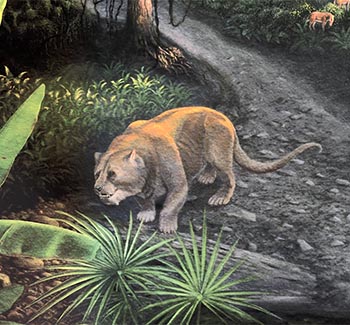Last updated: April 15, 2020
Lesson Plan
Survival of the Fittest

- Grade Level:
- Upper Elementary: Third Grade through Fifth Grade
- Subject:
- Science
- Lesson Duration:
- 30 Minutes
- Additional Standards:
- 3rd Grade: 3-LS4-1, 3-LS4-2, and 3-LS4-3
4th Grade: 4-LS1 and 4-LS1-1
5th Grade: 5-LS2, LS2.A, and LS2.B
6th Grade: MS-LS1-4, LS1.B, MS-LS2, MS-LS2-1, and LS2.A
Essential Question
1. Why do some animals thrive in certain environments better than others?
2. What can fossils can tell paleontologists about ancient environments?
Objective
Identify how animals have adaptations that are suited to their environment.
Background
Teachers should read and review information in Biodiversity and Adaptation with students.
Preparation
Materials:
Whiteboard or large poster
Drawing/coloring utensils
Procedure
Step One: Choose two animals from very different habitats, such as a polar bear (arctic tundra) and African elephant (savanna grassland). Discuss with your class how each animal is adapted for its environment. Some examples include a polar bear has fur with layers of fat underneath adapted for insulation and warmth and an elephant has large ears adapted to fan away pests and let out heat from its body. The class could produce detailed diagrams of the animals' bodies and how the different components are suited to their respective environments.
Step Two: Create a 'Polarphant' and an 'Elebear' (polar bear and elephant which have been transported to the opposite environments and adapted appropriately). This will really get the students thinking about what they would need to change about the animal if it moved habitats.
Step Three: On a whiteboard or large poster write out the following for students to complete individually.
My animal is...
Its environment is...
It looks like...
Its first adaptation is...
This helps my animal survive by...
Its second adaptation is...
This helps my animal survive by...
Its third adaptation is...
This helps my animal survive by
Each student should choose one environment (desert, forest, Amazon, mountainous, subterranean, oceanic...) and then design their own imaginary animal specially made for that environment. Students can draw the animal in its environment. The student should list three specialized adaptations that their animal possesses and describe how each adaptation aids in its survival.
Step Four: As a class, discuss the following question together: 1) Why do some animals thrive in certain environments better than others? 2) Why do you think having different types of environments and therefore different types of animals is a good thing? 3) What can fossils can tell paleontologists about ancient environments?
Step Five: Complete Physical or Behavioral Adaptation Lesson Plan.
Step Six: Complete Which Bone Goes Where Lesson Plan.
Step Seven: Complete the Post-Unit Questions found on Biodiversity and Adaptation.
Vocabulary
Abiotic factors: non-living components of an environment such as climate, soil, and water.
Adaptations: any physical or behavioral characteristics of an organism that help it to survive in its environment.
Behavioral adaptation: something an animal does usually in response to some type of external stimulus in order to survive. Hibernating during winter is an example of a behavioral adaptation.
Biodiversity: measure of the variety of life on Earth, including habitat diversity, and the interconnectedness that ties life and habit together.
Biotic factors: living components of an environment such as plants and animals.
Environment: all the influences, both biotic and abiotic in nature, which affect an organism.
Paleoecology: the study of ecosystems of the past through the fossil record.
Physical adaptation: type of structural modification made to a part of the body.
